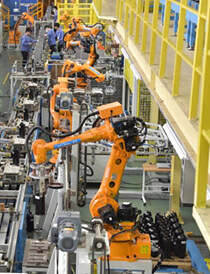- Western focus on first-technology-to-market, in contrast to China’s first-to-dominate-trade pragmatism: did the west miscalculate China’s “copycat” approach would delimit it to be a mere factory for the world?
- What are the implications of Made In China’s next phase for world industry, robotics, and other technologies?
- Why is China pushing towards advanced manufacturing that would displace human labor, given its enormous population and large disparities in regional economic development?
A Chinese friend once pointed out how outsiders still do not see how democracy can be a remote abstraction to a rural Chinese preoccupied with everyday basics. In various other different articles, I have discussed our need to see beyond ourselves; to look beyond current frames… and past successes.
President Xi has a long-standing promise to spread economic development to its lagging regions. China seeks to maintain its worldwide dominance in advanced manufacturing. But China’s success as the factory of the world has pushed average annual wage in three years from 58k to 74.6k yuan in 2020. Average wage of urban private companies have tripled from 2010 to 2020. Its working population is shrinking. Advanced manufacturing has also been the engine of its phenomenal dominance of world trade. China savvily sees private enterprise as an instrument of statecraft and policy.
Should we be surprised by how China lavishes subsidies on the robotics industry – such subsidies accounting for 20 percent of the industry’s net profit. Thousands of factories across the country are replacing manual labor with automation, robotisation and digitalization.
In terms of robotics density, China places behind Singapore and South Korea. But “density” is a tricky stat. China is large country with an enormous population. (Similarly, China seems to lag in internet access, which is reportedly available to “only half” of its population.) Further, that low penetration rate actually signals how much China has yet to flex its market potential. China has actually been the world’s largest industrial robot market since 2013.
The west largely believes China to be dependent on western technology development. Copycat is a fundamental term in Chinese culture, but its negative connotations are shrugged off by pragmatism.
South China Morning Post authors Josh Ye, Masha Borak and Orange Wang write about Midea and give us insight into China’s push towards Industry 4.0. Air-conditioner manufacturer Midea is a good case study: first buy equipment; then the company and their technologies; then on to world predominance. Thus Midea has leapfrogged the slow, flat preadoption curves that face original developers.
- Midea acquired German industrial robot manufacturer Kuka in 2017.
- The company has, over the last six years, invested 4 billion yuan (US$622 million) to transform itself, raising efficiency by 62 per cent and reducing its workforce by 50,000.
- A per-unit labor cost of 10 yuan ($1.60) is achieved with six human workers.
- What used to require 16 people now only needs four.
- Midea/Kuka also now develops robotics technologies: an 800,000 square metre, 10 billion yuan industrial estate that will house three Midea-Kuka ventures.
- The new complex will have the annual capacity to produce 75,000 industrial robots by 2024.
(As I’m posting this article, China’s President Xi is reportedly asking his team for softer diplomacy as China faces a widening pushback worldwide. To President Xi’s “good cop” role, while “bad cop” is played by Premier Li Keqiang along with Foreign Ministry spokesperson Zhao Lijan and Premier and the younger generation “wolf-warriors”. China’s approach has always been a duality. Pursuing its “Made In China 2025” objective, China toughly enforces its advantage when small-nation debtors default; or in aggressively muscling into the South China Sea. The west has been largely complicit to all these, in its eagerness for access into China.)

